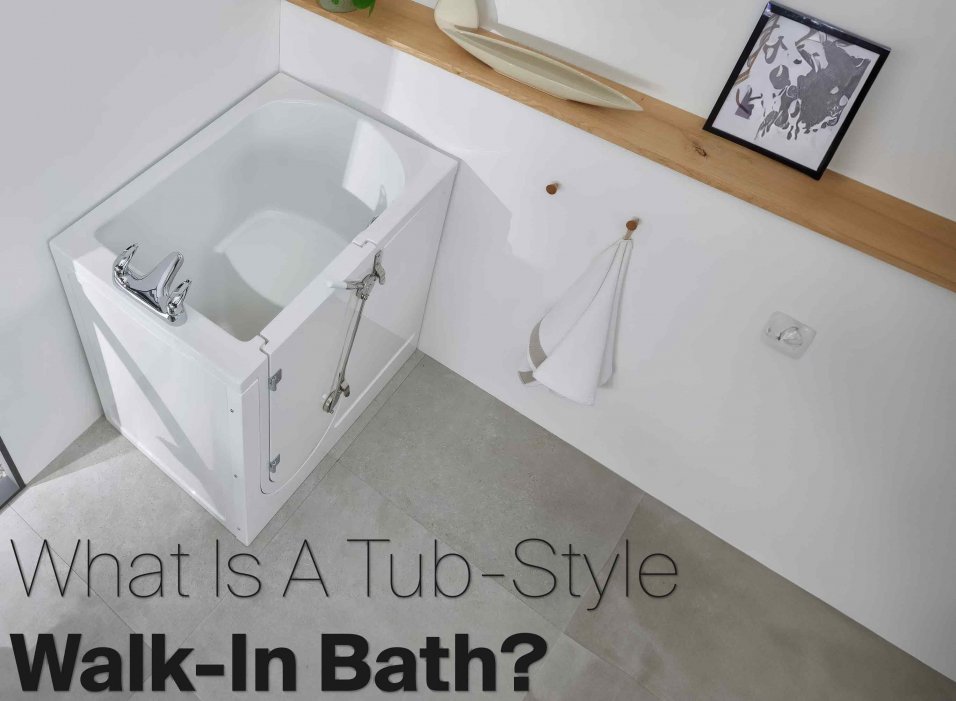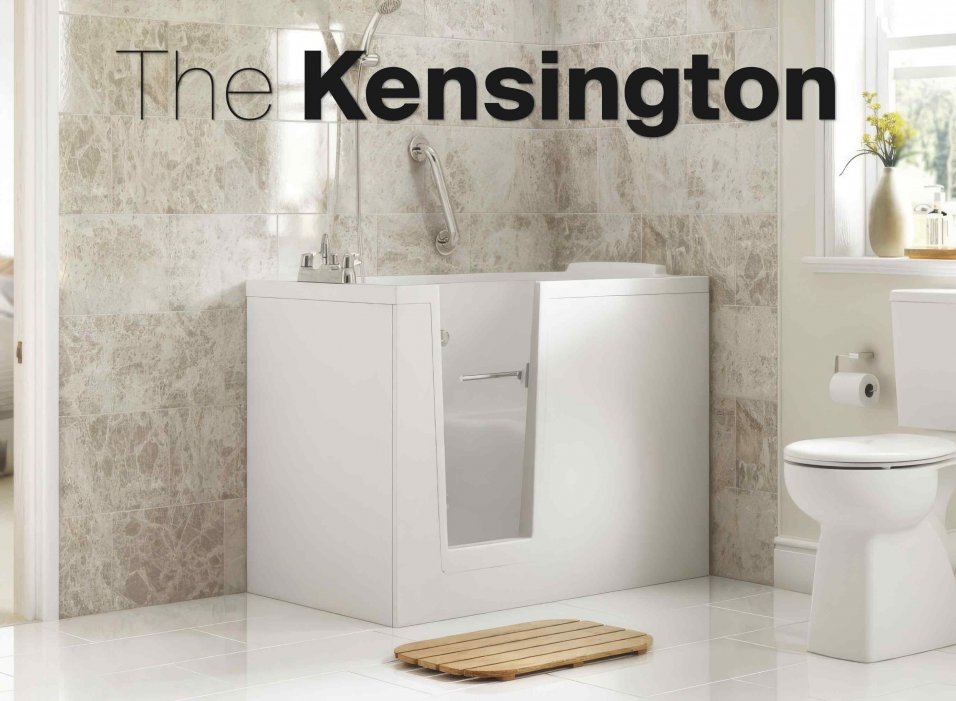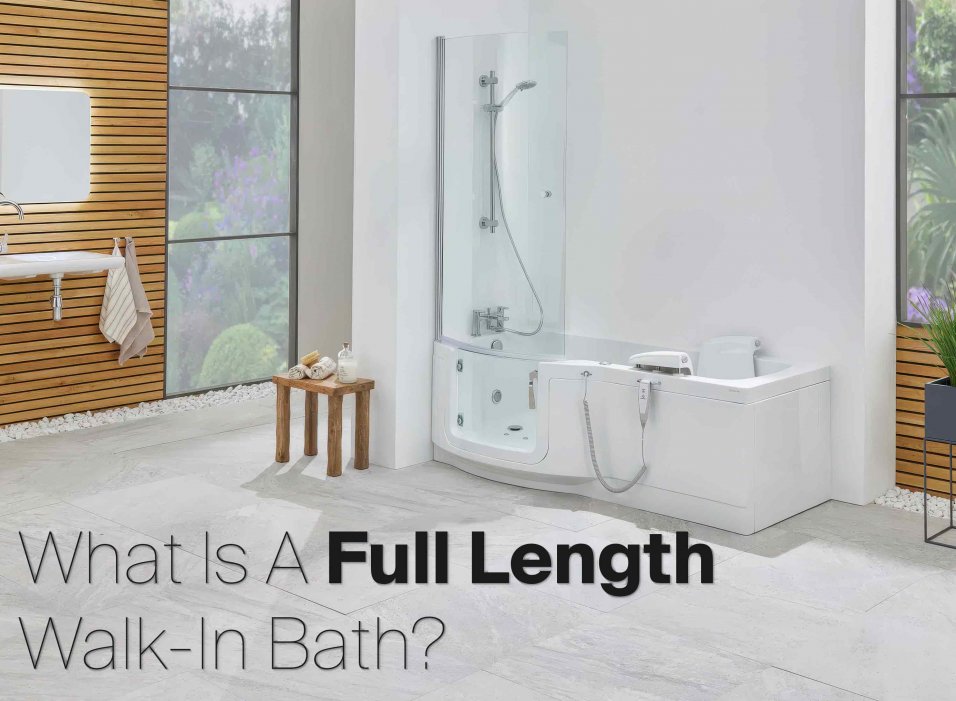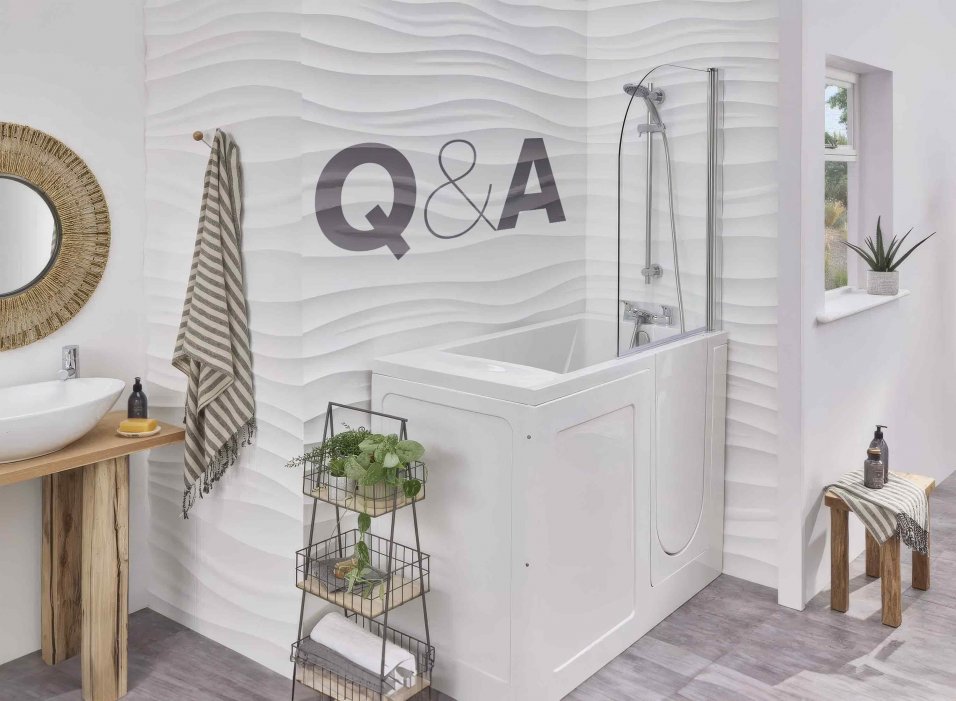| Tags | walk-in bath bath easy riser montana priya tray sizes anti-slip shower tray sizes shower tray freestanding baths geberit aquaclean aquaclean carron corner bath carron baths show all posts |
Choosing the Right Walk-In Bath: Tub Style vs Full Length
Whether you're renovating your bathroom or considering new additions to accommodate accessibility needs, understanding the different types of walk-in baths available can significantly enhance both the functionality and comfort of your space. Today, we’ll delve into the distinctions between tub-style and full-length walk-in baths, helping you determine which best suits your personal requirements and the layout of your bathroom.
Walk-in baths are more than just a luxurious addition to modern bathrooms; they're a pivotal investment in one’s quality of life, especially for those facing mobility challenges. By the end of this post, you’ll have a clearer picture of how these fixtures can transform your bathroom experience, making it safer and more enjoyable.
What are Walk-In Baths?
The concept of a walk-in bath might seem self-explanatory, but there’s quite a bit more to these innovative fixtures than meets the eye. Walk-in baths are specially designed bath that offer easy access through a side door, eliminating the need to step over a high wall to enter the bath. This feature alone makes them an invaluable asset for the elderly, those with mobility issues, or anyone who finds entering and exiting a traditional bath challenging.
The Evolution of Walk-In Baths
Walk-in baths are not a new concept, but their design and technology have evolved significantly over the years. Originally developed as practical solutions for those with limited mobility, these baths have transcended their utilitarian roots to become stylish fixtures in modern bathrooms. Today’s walk-in baths are equipped with various features, such as whirlpool jets, adjustable shower heads, and in-built seats, combining safety with spa-like luxury.
Benefits of Walk-In Baths
Walk-in baths have the primary benefit of improving bathroom safety. By featuring a door that provides direct walk-in access, these baths minimise the risk of slips and falls associated with traditional bathtubs. Here’s how a walk-in bath can make a difference:
Safety: The low threshold for entry, non-slip flooring, and built-in handrails significantly reduce the risk of accidents in the bathroom.
Accessibility: For those with reduced mobility, walk-in baths restore a level of independence in personal care routines.
Comfort and Therapeutic Advantages: Many walk-in baths come with therapeutic features such as hydrotherapy jets, which can help in relieving pain and improving circulation.
Style and Value: Modern walk-in baths are designed to be visually appealing, ensuring that they enhance the aesthetic of your bathroom while potentially increasing your home’s market value.
Let’s focus on one of the two main types we’re discussing today: the tub-style walk-in bath. This variant is particularly popular due to its compact design and ease of use, making it an excellent choice for smaller bathrooms or for users who prefer a quicker bathing option with added safety features.
What is a Tub-Style Walk-In Bath?
A tub-style walk-in bath resembles a traditional bathtub but comes with a door on the side that allows for easy access. Unlike the full-length models, these are typically shorter in length but might be taller, helping to maximise the use of vertical space in a smaller bathroom. The door provides a watertight seal when closed, ensuring no water escapes during use.
Typical Dimensions and Design Features
The average dimensions of a tub-style walk-in bath can vary, but most are about 3 to 4 feet in length and around 2.5 to 3 feet in width. What sets these apart is their height, which can be anywhere from 3 to 4 feet, providing enough depth for a substantial water level despite the smaller footprint.
Tub-style walk-in baths often have the following design features:
Built-in Seating: Most models come with a built-in seat, allowing the user to sit comfortably while bathing without needing to lower themselves to the floor of the tub.
Easy-to-Reach Controls: Thermostatic controls, water jets, and shower attachments are positioned within easy reach from the seated position, enhancing the user’s independence.
Non-Slip Flooring: Safety is paramount, and non-slip floors are a standard feature, reducing the risk of slips and falls.
Low Step-Over Entry: The step into the bath is typically just a few inches high, making it easier for those with limited mobility to access.
Pros of Choosing a Tub-Style Walk-In Bath
Opting for a tub-style walk-in bath brings several benefits, particularly suited to certain lifestyles and bathroom layouts:
Space Efficiency: This style is ideal for smaller bathrooms. Its compact design allows it to fit into spaces where a full-length bath wouldn’t be practical.
Built-In Seating: The integral seat is not only a safety feature but also provides comfort that is not available in standard bathtubs, particularly for those who find standing for prolonged periods challenging.
Ease of Use: With features like low step-over thresholds and nearby controls, these baths make it possible for individuals with restricted mobility to use the bath without assistance.
Water Efficiency: Filling a tub-style walk-in bath requires less water than a full-length model, appealing to environmentally conscious users or those in regions with water usage restrictions.
Cons of Tub-Style Walk-In Baths
However, tub-style walk-in baths are not without their drawbacks, which might influence your decision depending on your specific needs:
Limited Immersion: Due to their smaller dimensions, these baths do not allow for full-body immersion, which can be a drawback for those who enjoy a deep soak.
Aesthetic Limitations: While highly functional, the compact and utilitarian design of tub-style baths may not blend seamlessly into all bathroom decors.
Longer Fill and Drain Time: Despite their smaller size, the deeper design means they can still take a while to fill and drain, which could be a consideration for those with tight schedules.
Example Of A Great Tub-Style Walk-In Bath: The Kensington
The Kensington walk-in bath is a prime example of a well-designed, luxurious bathing solution that combines safety, comfort, and style. This British-made bath showcases a deep soak design, ensuring a generous bathing space even in its compact form, which measures 1210mm in length, 660mm in width, and 965mm in height. The internal depth of 795mm allows for a satisfying soak, holding up to 225 litres of water when unoccupied.
Key features of the Kensington walk-in bath include its inward-opening door, which utilises the pressure of the water to ensure a tight, leak-proof seal. This is essential for maintaining both safety and convenience during use. The construction of the bath from strong glass-reinforced plastic (GRP) contributes to its durability and rigidity, preventing any unwanted movement during use.
Safety elements are thoughtfully integrated, including a contoured seat at a height of 365mm and a non-slip floor, making it accessible and secure for users with mobility issues. The low step height of just 150mm further enhances its accessibility, making it a suitable option for a wide range of users.
For those interested in customising their bathing experience, the Kensington offers several optional features. These include a choice of taps—either a simple thermostatic bath filler or a more versatile thermostatic bath/shower mixer. For an added touch of luxury, a 12 jet spa system can be installed, along with chromotherapy lighting to create a therapeutic, relaxing ambiance. Additional practical options include the installation of end panels and a bath screen, and for added comfort, a range of booster seats are available to adjust the seating height.
The Kensington walk-in bath represents excellent value for money, emphasising its quality without hidden costs. It is backed by substantial guarantees, including a lifetime guarantee on the door seal and a one-year warranty on the bath itself. Furthermore, the product qualifies for VAT exemption under certain conditions, offering additional financial benefits to eligible buyers. This makes the Kensington an appealing choice for those seeking a reliable and indulgent bathing solution that does not compromise on safety or comfort.
In conclusion, tub-style walk-in baths offer a practical solution for those with smaller spaces or specific safety and accessibility needs. They provide a safe, comfortable, and water-efficient bathing option but may not satisfy everyone, especially those looking for a luxurious full-body soak.
By understanding these details and weighing the pros and cons, you can make a more informed decision about whether a tub-style walk-in bath is the right choice for your home.
The second main type of walk-in bath is the full-length walk-in bath. This style is closer in form and function to traditional bathtubs, but with the critical modification of accessibility features. Ideal for those who have the space and prefer a more conventional bathing experience, full-length walk-in baths combine the familiar with the functional.
What is a Full-Length Walk-In Bath?
Full-length walk-in baths are designed to offer the same length and breadth as standard bathtubs but include a door for easy access. This design targets users who desire the comfort and relaxation of a traditional bath without the accessibility challenges posed by high tub walls.
Typical Dimensions and Design Features
Typically, these baths measure around 5 to 6 feet in length, which is comparable to standard tubs, and about 2 to 3 feet in width. The key features include:
Door Entry: Like tub-style, these baths have a watertight door that allows for easy access, but in a full-length format.
Safety Features: Equipped with non-slip floors, handrails, and low-entry points for safer access and exit.
Comfortable Lying Position: Unlike the seated position in tub-style baths, full-length baths allow users to lie down fully, mimicking the traditional bath experience.
Customisable Hydrotherapy Options: Many models come with options for whirlpool jets or air baths, enhancing the therapeutic aspects of bathing.
The Advantages of Choosing a Full-Length Walk-In Bath
There are several advantages to choosing a full-length walk-in bath, particularly for those who value a more traditional bath experience:
Full-Body Immersion: These baths allow for a full-body soak, providing a more relaxing and immersive experience.
Traditional Bath Experience: For many, the ability to lie down fully in a bath is non-negotiable, making these models more akin to conventional bathtubs in terms of user experience.
Therapeutic Benefits: The option to include various hydrotherapy features can turn a simple bath into a therapeutic session, helping to relieve muscle and joint pain.
Cons of Full-Length Walk-In Baths
However, full-length walk-in baths might not be suitable for everyone, given certain limitations:
Space Requirements: These units require the same amount of space as traditional bathtubs, which can be an issue in smaller bathrooms.
Higher Water Usage: Filling a full-length bath typically uses more water than smaller models, which might be a concern in areas with water usage restrictions or for those seeking to reduce their environmental footprint.
Longer Fill and Drain Times: Due to their size, these baths can take longer to fill and drain, which might require planning your bath time more carefully to accommodate these delays.
Example Of A Great Full Length Walk-In Bath: The Avrail
The Avrail walk-in bath is a superb blend of functionality, safety, and contemporary design, all crafted in the UK. It is available in two lengths, 1500mm and 1700mm, both with a width of 700mm, making it a versatile option for different bathroom sizes. The bath features a modest internal depth of 395mm and a step height of 170mm, designed to facilitate easier access, particularly beneficial for those with reduced mobility.
In terms of construction, the Avrail is built using glass-reinforced plastic (GRP), ensuring durability and stability without any flex during use. One of its standout safety features is the inward-opening door, which leverages the pressure of the water to enhance the seal and prevent leaks, offering users peace of mind.
The bath offers a variety of customisation options, including the option of adding thermostatic taps either as a bath filler or a bath/shower mixer, which enhances its utility. For those seeking a touch of luxury and relaxation, a 12-jet spa system can be installed, along with optional chromotherapy lighting, which can help create a serene bathing environment.
Not only does the Avrail walk-in bath emphasise practical design and user safety, but it also represents excellent value for money. The product is supported by a comprehensive guarantee, which includes a lifetime guarantee on the door seal and a one-year warranty on the bath itself. Furthermore, it qualifies for VAT exemption under certain conditions, which could provide financial relief to eligible buyers.
This model is an exemplary choice for anyone looking to combine safety, ease of use, and a touch of luxury in their bathing experience.
In conclusion, full-length walk-in baths offer a blend of traditional bath experiences with enhanced accessibility, making them an attractive option for those who can accommodate their larger size and water usage. They are ideal for users who seek comfort in their familiarity but require a safer, more accessible bathing solution.
Installation Considerations
Choosing the right walk-in bath is just the first step; understanding the installation process is crucial to ensuring that your new bath fits seamlessly into your home and functions optimally. Whether you opt for a tub-style or a full-length walk-in bath, several key considerations must be addressed to prepare your bathroom for installation.
Overview of Installation Requirements
Installing a walk-in bath involves more than simply replacing an old bath. Both types of walk-in baths have specific requirements that might necessitate significant bathroom modifications:
Space Requirements: Ensure that the chosen model fits into the existing space or consider whether the bathroom layout needs rearranging. Full-length baths generally require more space, similar to traditional tubs, while tub-style baths are more flexible for tighter spaces.
Plumbing Adjustments: Depending on the bath’s orientation and features, plumbing may need to be relocated or upgraded, which can include adjusting water supply lines and drain systems.
Support and Weight Considerations: Walk-in baths are typically heavier than standard baths, especially when filled with water. It's essential to ensure that the floor can support this weight without risk.
Electrical Installations: If your chosen bath includes hydrotherapy features, proper electrical wiring and grounding will be required, in accordance with local building codes.
Necessary Bathroom Modifications
Modifying your bathroom for a walk-in bath installation can be extensive or minimal, depending on the existing setup.
Door Width: To accommodate bath delivery and installation, the bathroom door may need to be widened to accommodate the delivery and installation of the bath.
Ventilation: Adequate ventilation is crucial, especially if hydrotherapy features are used, to prevent moisture buildup and mould growth.
Wall Adjustments: Some installations might require changes to the bathroom walls, particularly if converting from a shower-only setup to a walk-in bath.
Accessibility Features: Additional modifications might include installing grab bars, anti-slip flooring, and accessible shower controls to enhance safety and usability.
Estimated Installation Costs and Time Frames
The cost and duration of installing a walk-in bath can vary widely based on several factors:
Type of Bath: Full-length baths might be more expensive to install due to their size and the more extensive plumbing and floor reinforcement they require.
Installation Complexity: The need for additional bathroom modifications, such as plumbing changes and floor reinforcement, will increase the cost and time required for installation.
Local Labour Costs: Installation costs can vary depending on where you live and the rates charged by contractors in your area.
Preparation Work: Any preliminary work, such as removing the existing bathtub or making structural changes to accommodate the new bath, will also factor into the overall cost and timeline.
On average, the installation of a walk-in bath can take from a few days to a week, depending on the complexity of the job and the speed of the workers. Costs can range from a few thousand pounds for a straightforward replacement to much higher for more complex renovations.
In summary, while the installation of a walk-in bath can be a significant undertaking, proper planning and understanding of the requirements can ensure a smooth process. It's advisable to consult with professional installers who can provide a detailed assessment and quote based on your specific needs and bathroom conditions. This careful preparation will help you enjoy the full benefits of your new walk-in bath with minimal disruption and maximum safety.
What are the key safety features in walk-in baths?
Safety is a top priority when designing walk-in baths. Key features typically include:
Low Threshold Entry: Reduces the risk of trips and falls.
Built-In Seating: Allows users to bathe comfortably without the need to lower themselves to the floor.
Non-Slip Textured Floors: Provides additional grip to prevent slipping.
Grab Bars: Strategically placed to aid in safe entry and exit.
Anti-Scald Technology: Thermostatic control valves are used to prevent sudden temperature changes.
Emergency Exit Features: Some models include a quick-release door system in case of emergencies.
These features collectively contribute to making walk-in baths a safer alternative to traditional tubs, especially for those with limited mobility or balance issues.
How do I decide between a tub-style and a full-length walk-in bath based on my mobility needs?
Choosing between a tub-style and a full-length walk-in bath depends largely on your mobility level and bathroom space:
Tub-Style Baths: Best for those who require seated bathing and have limited space. Ideal for users who find it difficult to stand for long periods.
Full-Length Baths: Suitable for individuals who can lie down and stand with minimal assistance, offering a more traditional bathing experience. It requires more space and often more water.
Consider your current and future mobility needs, bathroom dimensions, and personal bathing preferences when making your decision.
Are there any financial assistance programmes available for installing walk-in baths?
Yes, financial assistance might be available for those installing walk-in baths, depending on your location.
Government Grants: In some regions, grants are available for home modifications to aid the elderly or those with disabilities.
Insurance Coverage: Check with your health insurance or local social services to see if walk-in baths are covered under home modification benefits.
VAT Exemptions: At Bathroom Supplies Online, products designed for the disabled can be purchased VAT-free.
How long does installation take, and will it disrupt daily life?
Installation time can vary from a couple of days to a week, depending on the complexity of the installation and pre-existing bathroom conditions. While installers strive to minimise disruption, some inconvenience is inevitable. It's wise to plan accordingly, perhaps arranging alternative bathing facilities if needed during the installation period.
What warranty and maintenance considerations should I take into account?
When purchasing a walk-in bath, consider the following:
Warranty: Most walk-in baths come with a warranty. Check the length and what it covers—some might include parts and labour, while others only cover the bath.
Maintenance: Regular maintenance is crucial to ensure longevity and performance. Ask about easy-clean features and access panels for simple servicing.
Service: Look for suppliers that offer comprehensive after-sales service, including spare parts and repair services.
Understanding these factors will help ensure that your walk-in bath remains in excellent condition over its lifespan.
Can walk-in baths be customised to fit specific bathroom dimensions?
Yes, many manufacturers offer customisable options for walk-in baths to fit specific bathroom dimensions and user needs. Customisation can include adjusting the size, door orientation, and adding specific features like extra grab bars or different hydrotherapy systems. Always consult with a professional to assess what customisations are possible for your specific space.
What are the energy and water consumption rates of these baths?
Walk-in baths vary in their water and energy consumption, generally determined by their size and the features they include:
Water Usage: Full-length baths typically use more water than tub-style baths due to their larger capacity.
Energy Consumption: Features like hydrotherapy jets and heated seating increase energy usage. Consider models with energy-efficient pumps and heaters.
It’s important to evaluate these factors based on how often the bath will be used and the cost of water and energy in your area.
How do walk-in baths affect the resale value of a home?
Installing a walk-in bath can potentially increase the resale value of your home, particularly if marketed towards buyers with accessibility needs or those looking for homes that can accommodate ageing in place. However, the impact on resale value can vary depending on the market and the buyer's preferences. Consult with real estate professionals to understand how such a modification might affect your home’s value in your specific area.
In this comprehensive guide, we've explored the nuances of both tub-style and full-length walk-in baths, their installation requirements, and addressed some of the most pressing questions potential buyers might have. We've highlighted the importance of safety features, the considerations needed for choosing the right type of bath based on individual mobility needs, and discussed the financial and practical aspects of installation.
Choosing the right walk-in bath requires careful consideration of your specific needs, space, and long-term comfort. We strongly advise consulting with professionals who can provide insights and recommendations tailored to your unique situation, ensuring that your new bath not only enhances your quality of life but also aligns seamlessly with your home’s design.
Call to Action
Ready to take the next step towards enhancing your bathroom with a walk-in bath? Don’t navigate this significant decision alone. Our experts at Bathroom Supplies Online are here to give you personalized advice and help you find the perfect solution that meets your specific needs.
Visit bathroomsuppliesonline.com to explore your options and find the perfect walk-in bath for your home. Whether you are considering a tub-style or a full-length walk-in bath, we have a range of options to suit every need and budget. Contact us today to ensure your bathroom transformation is both safe and stylish!











